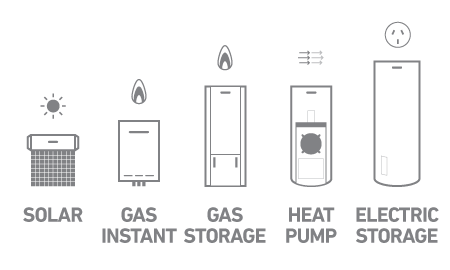 CALL US NOW 1300 232 491
CALL US NOW 1300 232 491We always end up getting confused while choosing the ideal water heating system for our home.
And even after finding the perfect system, the problems don’t seem to end. There’s either an issue with getting it set up or it suddenly stops working. Well, what if we told you that there’s a solution to all these problems?

All you have to do is understand how a hot water system works. This will not only help you in the installation process but will also enable you to figure out the issue if it fails to work. As such, you won’t have to call a professional plumber to get it fixed or set up.
So, what are you waiting for? Dive into our brief guide.
Here, we’ll be discussing the working mechanisms of the different types of hot water systems categorised based on their power-source (electric, gas, and solar-powered). Let’s get going!
Ideally, there are two primary types of hot water systems – storage and continuous. Storage hot water systems heat water and store it in an insulated tank. On the contrary, continuous systems are tankless models; they only heat water when required and tend to be powered by gas.
You also get electric and solar-powered options that commonly include a tank. Now the basic working principle of the different water heater types are quite similar, but they might differ slightly depending on the power source.
So, to help you understand how hot water systems work, we’ll be discussing the working mechanism of each type. Let’s begin.
An electric water heater brings in cold water through the dip tube and heats it using electric heating elements located at the bottom of the unit. This helps keep the water warm as it rises in the tank and travels throughout your home via the heat-out pipe.
But the location of the heating elements differs in continuous systems (tankless) where they are wrapped around pipes to heat water while it travels to the taps.
Furthermore, both tank and tankless units come with a thermostat, allowing you to set the water temperature as per your requirement. At the same time, the temperature and pressure (T and P) valves open and release water in case it becomes too hot or the pressure inside turns too high. So, you won’t have to bother about the tank exploding thanks to these protective measures.
Like electric heaters, gas-powered systems bring cold water into the tank through a dip tube, but this water is heated using a gas burner. It burns gas, releasing extremely hot and toxic air through the chimney in the middle of the tank. And while this chimney heats up, the water in the tank heats up as well.
The warm water rises to the top of the tank and then travels throughout your home’s heat-out pipeline. So, when you open the tap for hot water, the cool water is brought in through the dip tube, displacing the hot water and pushing it through the pipe.
You can also set the desired temperature using the thermostat that’s connected to the gas line. It will bring the right amount of gas to the burner to reach the required temperature.
However, it’s important to note that continuous systems don’t use the gas burner unless the hot water tap is turned on.
Unlike electric and gas hot water systems, solar-powered systems heat water by harnessing energy from the sun using the solar panels installed on your roof. Now, in closed-loop or indirect systems, a non-freezing liquid is used to transfer the heat energy derived from the sun to the water stored in the tank.
The thermal energy heats the fluids in the solar collectors, which is then passed through a heat exchanger in the storage tank where the heat is transferred to the water. Once the water is heated, the non-freezing fluids cycle back to the collector to repeat the process.
That said, the heating process works a bit differently in case of direct systems. Here the water is circulated through solar collectors where it’s heated directly by the sun. This water is then stored in the tank or flows directly through the tap in continuous or tankless heaters.
Ideally, twin or dual-element hot water systems are more efficient than their single-element counterparts. However, they are more expensive when it comes to installation.
Now single-element heaters come with one heating element located at the tank’s bottom, and they are generally set to work overnight when the power is at an off-peak rate. This will help you save money.
But dual-element systems include two heating elements in the tank – one at the top and the other at the bottom. They work in harmony to heat water more evenly.
Hot water systems are lifesavers, especially if you live in a colder region with prolonged winters. So, it’s a good idea to get acquainted with their working mechanism. This will also serve as a deciding factor to help you choose the type of unit that best meets your requirements.
On that note, we’ll now conclude our informative guide on the topic. But before taking your leave, we’d like to share a few valuable tips to maintain your water heater.
First, always set the thermostat to a safe temperature. We’d recommend setting it to an optimal temperature of 120 degrees to save costs on electricity bills. Other than that, flush out sediment from the tank annually to prevent the system from failing prematurely.
That’s all for now. But we’ll be back with more useful guides very soon. Till then, take care!